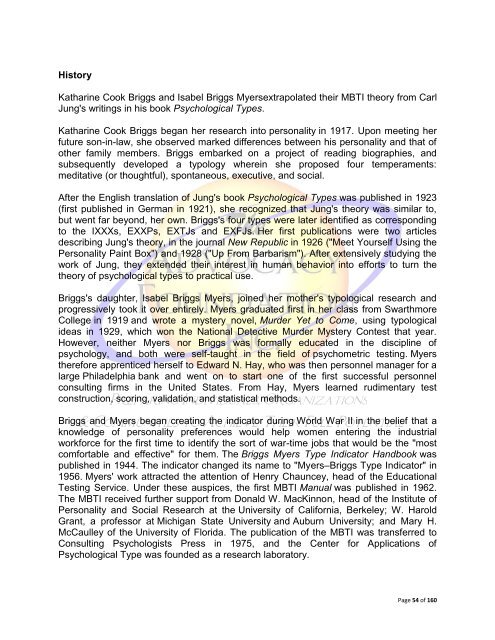The Gift of Introversion
The Gift of Introversion
The Gift of Introversion
Create successful ePaper yourself
Turn your PDF publications into a flip-book with our unique Google optimized e-Paper software.
History<br />
Katharine Cook Briggs and Isabel Briggs Myersextrapolated their MBTI theory from Carl<br />
Jung's writings in his book Psychological Types.<br />
Katharine Cook Briggs began her research into personality in 1917. Upon meeting her<br />
future son-in-law, she observed marked differences between his personality and that <strong>of</strong><br />
other family members. Briggs embarked on a project <strong>of</strong> reading biographies, and<br />
subsequently developed a typology wherein she proposed four temperaments:<br />
meditative (or thoughtful), spontaneous, executive, and social.<br />
After the English translation <strong>of</strong> Jung's book Psychological Types was published in 1923<br />
(first published in German in 1921), she recognized that Jung's theory was similar to,<br />
but went far beyond, her own. Briggs's four types were later identified as corresponding<br />
to the IXXXs, EXXPs, EXTJs and EXFJs. Her first publications were two articles<br />
describing Jung's theory, in the journal New Republic in 1926 ("Meet Yourself Using the<br />
Personality Paint Box") and 1928 ("Up From Barbarism"). After extensively studying the<br />
work <strong>of</strong> Jung, they extended their interest in human behavior into efforts to turn the<br />
theory <strong>of</strong> psychological types to practical use.<br />
Briggs's daughter, Isabel Briggs Myers, joined her mother's typological research and<br />
progressively took it over entirely. Myers graduated first in her class from Swarthmore<br />
College in 1919 and wrote a mystery novel, Murder Yet to Come, using typological<br />
ideas in 1929, which won the National Detective Murder Mystery Contest that year.<br />
However, neither Myers nor Briggs was formally educated in the discipline <strong>of</strong><br />
psychology, and both were self-taught in the field <strong>of</strong> psychometric testing. Myers<br />
therefore apprenticed herself to Edward N. Hay, who was then personnel manager for a<br />
large Philadelphia bank and went on to start one <strong>of</strong> the first successful personnel<br />
consulting firms in the United States. From Hay, Myers learned rudimentary test<br />
construction, scoring, validation, and statistical methods.<br />
Briggs and Myers began creating the indicator during World War II in the belief that a<br />
knowledge <strong>of</strong> personality preferences would help women entering the industrial<br />
workforce for the first time to identify the sort <strong>of</strong> war-time jobs that would be the "most<br />
comfortable and effective" for them. <strong>The</strong> Briggs Myers Type Indicator Handbook was<br />
published in 1944. <strong>The</strong> indicator changed its name to "Myers–Briggs Type Indicator" in<br />
1956. Myers' work attracted the attention <strong>of</strong> Henry Chauncey, head <strong>of</strong> the Educational<br />
Testing Service. Under these auspices, the first MBTI Manual was published in 1962.<br />
<strong>The</strong> MBTI received further support from Donald W. MacKinnon, head <strong>of</strong> the Institute <strong>of</strong><br />
Personality and Social Research at the University <strong>of</strong> California, Berkeley; W. Harold<br />
Grant, a pr<strong>of</strong>essor at Michigan State University and Auburn University; and Mary H.<br />
McCaulley <strong>of</strong> the University <strong>of</strong> Florida. <strong>The</strong> publication <strong>of</strong> the MBTI was transferred to<br />
Consulting Psychologists Press in 1975, and the Center for Applications <strong>of</strong><br />
Psychological Type was founded as a research laboratory.<br />
Page 54 <strong>of</strong> 160

















